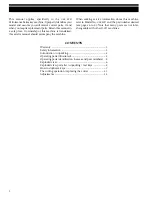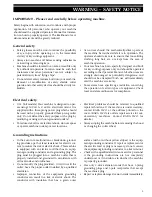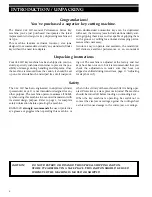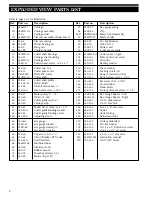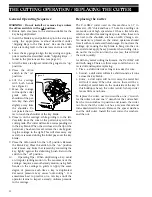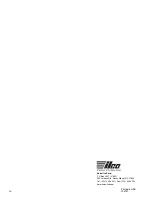
ADJUSTMENTS
13
Adjusting for depth of cut
To ensure safety, UNPLUG machine from its power
source before adjusting for depth of cut. It's imperative
that the key guide and the cutter be in the same plane,
that is, aligned to each other. If the cutter guide protrudes
further than the cutter, the resulting cuts in a key blank
will be too shallow and the duplicate key will not work.
Likewise, if the cutter guide is behind the cutter, the cuts
in the key will be too deep (see Fig. 6).
To check the depth adjustment, insert two identical key
blanks into the vise jaws, setting them flat in each vise.
(It is not necessary to align the blanks.) Then, raise the
carriage, positioning the left blank against the cutter
guide and the right blank against the cutter. Next, turn
the machine pulley by hand and note the right key blank.
The cutter should just barely graze the key blank when
the adjustment is correct.
No cutter is perfectly round so make one complete rota-
tion of the cutter before changing adjustment. There will
Figure 6
Depth Adjustment
Dial
Binding
screw
Adjustment is
correct when
both key blanks
touch
Figure 7
Carriage stop
adjusting screw
be a high point on the cutter; the adjustment should be
made to the high point. If the cutter does not touch the
key blank after one rotation, proceed to change the ad-
justment.
To adjust the cutter guide,
loosen the binding screw
on top of the cutter guide
slightly
. (see Fig. 7 & 8).
Once you have loosened
this screw, the depth
adjustment dial can be
rotated to the left (to
decrease depth of cut) or
to the right (to increase
depth of cut). Again,
proper adjustment will be
achieved when the cutter
just
barely grazes
the key blank before it while the cut-
ter guide is in contact with the other key blank. Retighten
the binding screw once the calibration process is com-
pleted. Recheck after tightening to assure that adjust-
ment did not shift.
Each calibration mark on the depth adjustment dial is
equivalent to approx. .0015” (1 1/2 thousandths of an
inch). As you can see, this system can allow for very pre-
cise adjustment of your new key machine. In fact, if you
have a key micrometer or dial caliper available, you can
adjust your machine with “factory accuracy”. To do this,
you would simply duplicate a key and measure cuts on
both the “pattern key” and the duplicate key for com-
parison. This would show any deviation that existed and
whether the duplicate cuts were too deep or too shallow
and by how much. With this information, you can use
the depth adjustment dial on your machine to calibrate
your machine for best possible accuracy. This is very
important as many locks are designed with close fit tol-
erances and the keys you duplicate are often themselves
copies; functional but just barely so. The more accurate
your key machine is adjusted, the closer your duplicates
will match their originals, resulting in fewer non-func-
tional miscuts!
It is very important
to understand that adjusting your
machine is not a “one time” procedure. As the cutter on
your machine wears down, the machine must be adjust-
ed to compensate. It is good shop practice to
check
you
machines’ depth adjustment every 2-4 weeks, based
upon your store’s key cutting volume and readjust as
necessary. You will find that re-calibration is seldom
needed, but by checking and correcting
BEFORE
cus-
tomers begin returning miscut keys, you will create a rep-
utation for your store as a “good place” to have keys
duplicated.
Figure 8
Depth
Dial
Binding
Screw
Carriage
Stop
Binding
Plate


